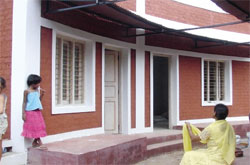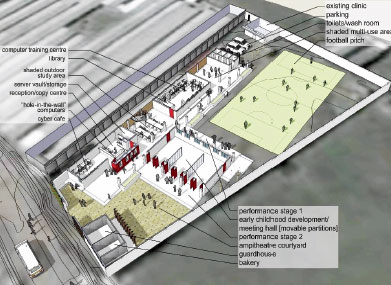By Ferdinand Mwongela
Deep in Mukuru Kwa Njenga slums, a group of boys play football next to an imposing iron sheet structure used as classrooms. The building will, however, not be there for long. It will soon be demolished to pave way for an ultra modern Information Communication Technology (ICT) centre thanks to a non-profit organisation, Architecture for Humanity, which has partnered with a local non-governmental organisation — Slums Information Development and Resource Centre (Sidarec) and 50x15 Foundation to introduce hi-tech information facilities to the youth of Mukuru Kwa Njenga.
Architecture for Humanity has offered professional services including the designing of the centre and are already partnering with the Mathare Youth Sports Association (MYSA) for a similar project in the Mathare Slum.
 |
Pillaichavady Kuppam Community Centre in India. It is one of the many projects Architecture for Humanity has designed. |
In the past, Kenya has been beleaguered by substandard workmanship when it comes to the construction of buildings to the extent that it has cost lives. Most of these fatal accidents are due to greed by developers or the desire to take shortcuts due to the high cost of construction.
Community centre
Architecture for Humanity offers the much needed professional advice to these rural and slum communities for free. The Sidarec technology centre is the organisation’s first project in Kenya. It has been based in Cape town, South Africa for a while though its headquarters are in San Francisco, California.
Formed in 1999 by Cameron Sinclair and his wife Cate Stohr in response to the need for shelter by refugees in Kosovo, the organisation has been spreading slowly through the provision of free professional advice and design services to communities around the world.
"Our core mandate is to bring design services closer to the people and to bridge the gap between people and professionals," says Isaac Mugumbule, a designer with Architecture for Humanity.
Mugumbule is currently based in the country, working closely with Sidarec in overseeing the construction of the community centre. He, however, points out they work with established community-based organisations and not individuals. In practise, Architecture for Humanity first evaluates the viability of the organisation in question and the programmes it offers to the community. It then assists the organisation based on the strength of the programmes and area where it is based.
"The design has to be workable within the community," Mugumbule says.
professional advice
Sidarec, for instance, was selected after a rigorous process because of its firmly established programmes. Although based in Pumwani where it has been for more than ten years, Sidarec has initiated several projects in Mukuru Kwa Njenga and Kibera where it runs early childhood development, clinics and a ghetto radio station among other ventures.
Lucy Mathai, Sidarec’s Executive Director, says her organisation got lucky after the third application seeking support. Sidarec started in 1996 with a pilot project in Majengo Pumwani but now runs four programmes targeting social issues in three slum areas.
Sidarec’s proposal was subjected to a design competition, which attracted about 160 designers. The successful candidate was selected by Global Studios in Seattle, USA. According to Mugumbule, the other designs were not discarded but kept aside to be used elsewhere.
"We were looking for designs that suit a technology centre," he says. "It has to respond to the context and budget element. Another key element is the response to the people and activities intended as well as its sustainability."
According to Mugumbule, the design has to look at sustainability issues and among the key requirements is the utilisation of locally available materials in the construction.
Besides design, Architecture for Humanity also gives professional advice on quantity surveying and engineering. It even helps organisations access funding for their projects.
During the duration of the construction project, design fellows are attached to the organisation and are part of the team. They are then allocated other projects as and when they arise. Mugumbule is the only one in Kenya currently having been sent from South Africa.  |
| Architectural design for the ICT centre. |
"We station ourselves within the community," he says in what sounds like a description of a modern day missionary in matters construction.
To qualify for support from Architecture for Humanity, an organisation must be well established in a community, run stable programmes and own the land on which it wants to construct a building.
"The organisation should also have the funding but if not we try to look for donors," Mugumbule says.
Knowledge Gap
Architecture for Humanity has over 72 chapters around the world. Operations in Africa are coordinated from Cape Town, South Africa. Some of the chapters operate individually, only going to the mother organisation to seek advice or assistance with projects. Mathai says the organisation chose an ICT centre because "ICT is the way forward. It is something we should encourage".
Launching the project, Dan Shine, the President of 50x15 Foundation, said the project was "aimed at creating a path to individual and community empowerment within the community and Nairobi city at large."
Mathai adds that in slum areas, young people are inquisitive and an ICT centre will bridge the knowledge gap. The facility will be open to the general public and will include classrooms, offices for Sidarec and the ghetto radio station, which is already in operation.
Mugumbule says the centre has been designed to include as many windows as possible for natural lighting and the ceiling
boards have been raised to allow natural ventilation.
While agreeing the centre will stand out almost out of place given the squalor surrounding it, Mugumbule says it will inspire pride and a sense of ownership within the community.
The centre will be co-financed by 50x15 Foundation.
 The Standard Group Plc is a multi-media organization with investments in media
platforms spanning newspaper print operations, television, radio broadcasting,
digital and online services. The Standard Group is recognized as a leading
multi-media house in Kenya with a key influence in matters of national and
international interest.
The Standard Group Plc is a multi-media organization with investments in media
platforms spanning newspaper print operations, television, radio broadcasting,
digital and online services. The Standard Group is recognized as a leading
multi-media house in Kenya with a key influence in matters of national and
international interest.
 The Standard Group Plc is a multi-media organization with investments in media
platforms spanning newspaper print operations, television, radio broadcasting,
digital and online services. The Standard Group is recognized as a leading
multi-media house in Kenya with a key influence in matters of national and
international interest.
The Standard Group Plc is a multi-media organization with investments in media
platforms spanning newspaper print operations, television, radio broadcasting,
digital and online services. The Standard Group is recognized as a leading
multi-media house in Kenya with a key influence in matters of national and
international interest.











